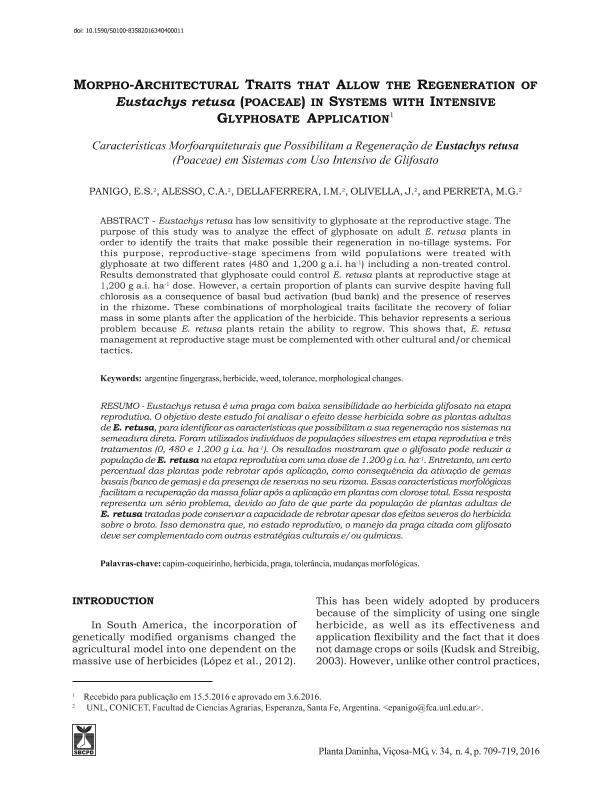Mostrar el registro sencillo del ítem
dc.contributor.author
Panigo, Elisa

dc.contributor.author
Alesso, Carlos Agustín

dc.contributor.author
Dellaferrera, Ignacio Miguel

dc.contributor.author
Olivella, Julia

dc.contributor.author
Perreta, Mariel Gladis

dc.date.available
2019-01-31T19:22:00Z
dc.date.issued
2016-10
dc.identifier.citation
Panigo, Elisa; Alesso, Carlos Agustín; Dellaferrera, Ignacio Miguel; Olivella, Julia; Perreta, Mariel Gladis; Morpho-Architectural Traits that Allow the Regeneration of Eustachys retusa (poaceae) in Systems with Intensive Glyphosate Application; Universidade Federal Vicosa. Sociedade de Investigacoes Florestais; Planta Daninha; 34; 4; 10-2016; 709-719
dc.identifier.issn
0100-8358
dc.identifier.uri
http://hdl.handle.net/11336/69152
dc.description.abstract
Eustachys retusa has low sensitivity to glyphosate at the reproductive stage. The purpose of this study was to analyze the effect of glyphosate on adult E. retusa plants in order to identify the traits that make possible their regeneration in no-tillage systems. For this purpose, reproductive-stage specimens from wild populations were treated with glyphosate at two different rates (480 and 1,200 g a.i. ha-1) including a non-treated control. Results demonstrated that glyphosate could control E. retusa plants at reproductive stage at 1,200 g a.i. ha-1 dose. However, a certain proportion of plants can survive despite having full chlorosis as a consequence of basal bud activation (bud bank) and the presence of reserves in the rhizome. These combinations of morphological traits facilitate the recovery of foliar mass in some plants after the application of the herbicide. This behavior represents a serious problem because E. retusa plants retain the ability to regrow. This shows that, E. retusa management at reproductive stage must be complemented with other cultural and/or chemical tactics.
dc.description.abstract
Eustachys retusa é uma praga com baixa sensibilidade ao herbicida glifosato na etapa reprodutiva. O objetivo deste estudo foi analisar o efeito desse herbicida sobre as plantas adultas de E. retusa, para identificar as características que possibilitam a sua regeneração nos sistemas na semeadura direta. Foram utilizados indivíduos de populações silvestres em etapa reprodutiva e três tratamentos (0, 480 e 1.200 g i.a. ha-1). Os resultados mostraram que o glifosato pode reduzir a população de E. retusa na etapa reprodutiva com uma dose de 1.200 g i.a. ha-1. Entretanto, um certo percentual das plantas pode rebrotar após aplicação, como consequência da ativação de gemas basais (banco de gemas) e da presença de reservas no seu rizoma. Essas características morfológicas facilitam a recuperação da massa foliar após a aplicação em plantas com clorose total. Essa resposta representa um sério problema, devido ao fato de que parte da população de plantas adultas de E. retusa tratadas pode conservar a capacidade de rebrotar apesar dos efeitos severos do herbicida sobre o broto. Isso demonstra que, no estado reprodutivo, o manejo da praga citada com glifosato deve ser complementado com outras estratégias culturais e/ou químicas.
dc.format
application/pdf
dc.language.iso
eng
dc.publisher
Universidade Federal Vicosa. Sociedade de Investigacoes Florestais

dc.rights
info:eu-repo/semantics/openAccess
dc.rights.uri
https://creativecommons.org/licenses/by-nc-sa/2.5/ar/
dc.subject
Argentine Fingergrass
dc.subject
Herbicide
dc.subject
Morphological Changes
dc.subject
Tolerance
dc.subject
Weed
dc.subject.classification
Agricultura

dc.subject.classification
Agricultura, Silvicultura y Pesca

dc.subject.classification
CIENCIAS AGRÍCOLAS

dc.title
Morpho-Architectural Traits that Allow the Regeneration of Eustachys retusa (poaceae) in Systems with Intensive Glyphosate Application
dc.title
Características Morfoarquiteturais que Possibilitam a Regeneração de Eustachys retusa (Poaceae) em Sistemas com Uso Intensivo de Glifosato
dc.type
info:eu-repo/semantics/article
dc.type
info:ar-repo/semantics/artículo
dc.type
info:eu-repo/semantics/publishedVersion
dc.date.updated
2019-01-22T18:50:25Z
dc.identifier.eissn
1806-9681
dc.journal.volume
34
dc.journal.number
4
dc.journal.pagination
709-719
dc.journal.pais
Brasil

dc.journal.ciudad
Viçosa
dc.description.fil
Fil: Panigo, Elisa. Consejo Nacional de Investigaciones Científicas y Técnicas. Centro Científico Tecnológico Conicet - Santa Fe; Argentina. Universidad Nacional del Litoral. Facultad de Cs.Agrarias. Departamento de Biologia Vegetal; Argentina
dc.description.fil
Fil: Alesso, Carlos Agustín. Universidad Nacional del Litoral. Facultad de Cs.Agrarias. Departamento de Biologia Vegetal; Argentina. Consejo Nacional de Investigaciones Científicas y Técnicas. Centro Científico Tecnológico Conicet - Santa Fe; Argentina
dc.description.fil
Fil: Dellaferrera, Ignacio Miguel. Consejo Nacional de Investigaciones Científicas y Técnicas. Centro Científico Tecnológico Conicet - Santa Fe; Argentina. Universidad Nacional del Litoral. Facultad de Cs.Agrarias. Departamento de Biologia Vegetal; Argentina
dc.description.fil
Fil: Olivella, Julia. Consejo Nacional de Investigaciones Científicas y Técnicas. Centro Científico Tecnológico Conicet - Santa Fe; Argentina. Universidad Nacional del Litoral. Facultad de Cs.Agrarias. Departamento de Biologia Vegetal; Argentina
dc.description.fil
Fil: Perreta, Mariel Gladis. Universidad Nacional del Litoral. Facultad de Cs.Agrarias. Departamento de Biologia Vegetal; Argentina. Consejo Nacional de Investigaciones Científicas y Técnicas. Centro Científico Tecnológico Conicet - Santa Fe; Argentina
dc.journal.title
Planta Daninha

dc.relation.alternativeid
info:eu-repo/semantics/altIdentifier/doi/http://dx.doi.org/10.1590/S0100-83582016340400011
dc.relation.alternativeid
info:eu-repo/semantics/altIdentifier/url/http://ref.scielo.org/5z2fy6
Archivos asociados
